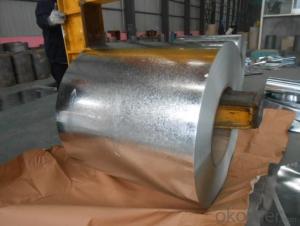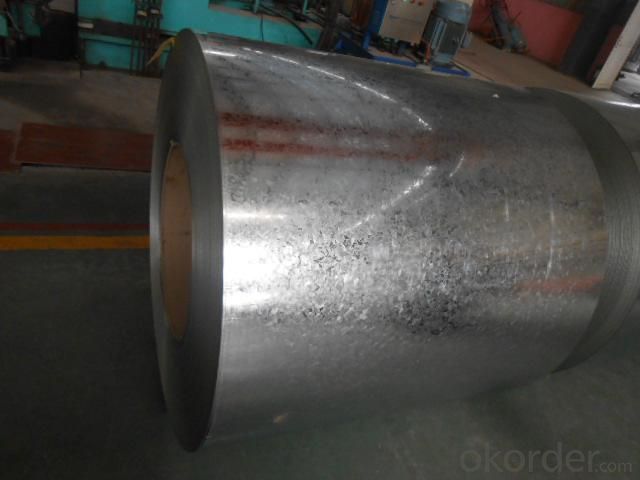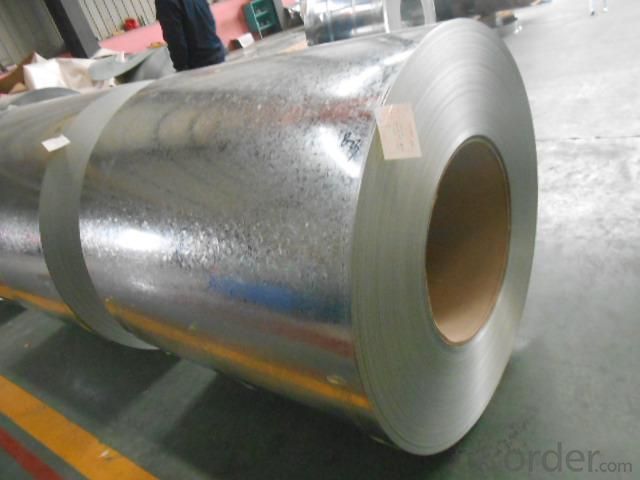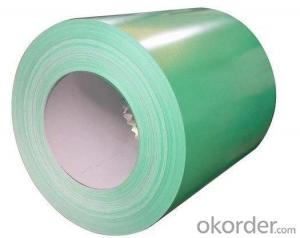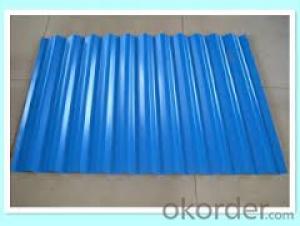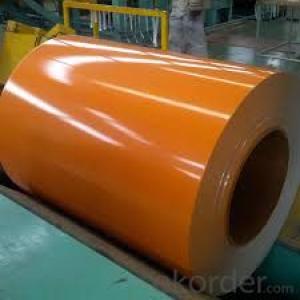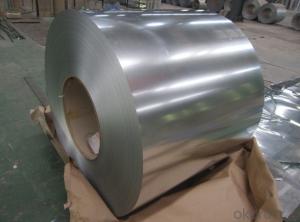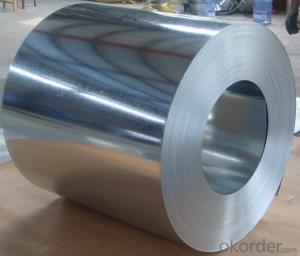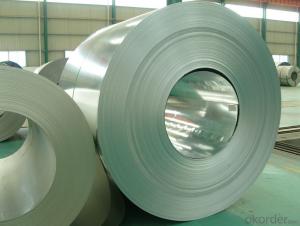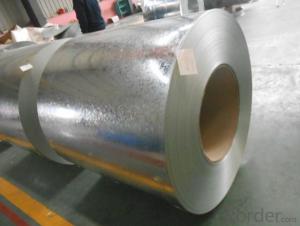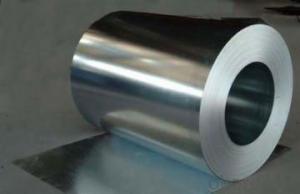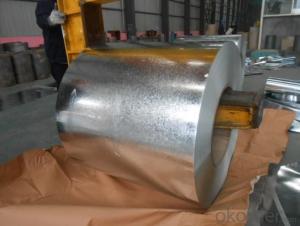Galvanized Steel Sheet in Ciols with First Class Quality Best Seller
- Loading Port:
- Tianjin
- Payment Terms:
- TT OR LC
- Min Order Qty:
- 50 m.t.
- Supply Capability:
- 20000 m.t./month
OKorder Service Pledge
OKorder Financial Service
You Might Also Like
1.Structure of Galvanized Steel Coil Description:
Hot-dip galvanized steel coils are available with a pure zinc coating through the hot-dip galvanizing process. It offers the economy, strength and formability of steel combined with the corrosion resistance of zinc. The hot-dip process is the process by which steel gets coated in layers of zinc to protect against rust. It is especially useful for countless outdoor and industrial applications.
2.Main Features of the Galvanized Steel Coil:
• Base material for countless outdoor and industrial applications
• High corrosion resistance
• High strength
• Good formability
• Rust- proof ability
• Good visual effect
3.Galvanized Steel Coil Images

4.Galvanized Steel Coil Specification
Operate Standard: ASTM A653M-04/JIS G3302/DIN EN10143/GBT 2518-2008
Grade : SGCD,SGCH, Q195,DX51D
Zinc coating :40-180g( as required)
Width:914-1250mm(914mm, 1215mm,1250mm,1000mm the most common)
Coil id:508mm/610mm
Coil weight: 4-10 MT(as required)
Surface: regular/mini/zero spangle, chromated, skin pass, dry etc.
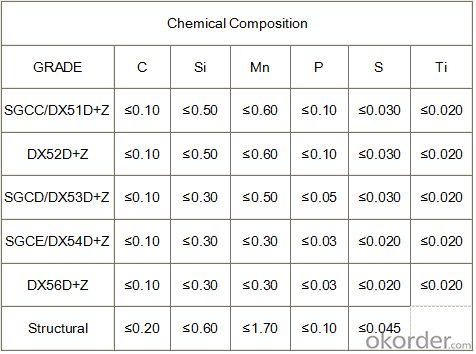
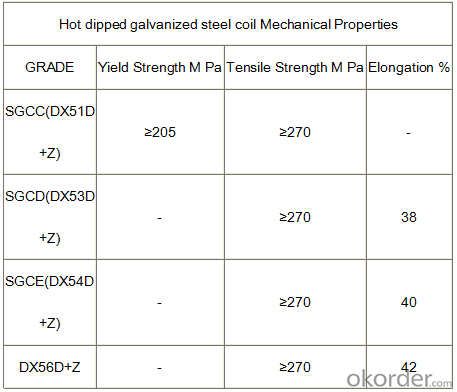
5.FAQ of Galvanized Steel Coil
We have organized several common questions for our clients,may help you sincerely:
1.How to guarantee the quality of the products?
We have established the international advanced quality management system,every link from raw material to final product we have strict quality test;We resolutely put an end to unqualified products flowing into the market. At the same time, we will provide necessary follow-up service assurance.
2. What is the minimum order quantity ?
Our MOQ is 50mt for each size. And we will consider to give more discount if you make big order like 1000 tons and more. Further more, the more appropriate payment term your offer the better price we can provide.
3.How long can we receive the product after purchase?
Usually within thirty working days after receiving buyer’s advance payment or LC. We will arrange the factory manufacturing as soon as possible. The cargo readiness usually takes 15-25 days, but the shipment will depend on the vessel situation.
- Q: How are steel coils inspected for mechanical properties?
- Steel coils are inspected for mechanical properties through a combination of destructive and non-destructive testing methods. Destructive methods involve conducting tensile, hardness, and impact tests on samples taken from the coils. Non-destructive methods, such as ultrasonic or magnetic particle testing, are also employed to detect surface and internal defects without damaging the coils. These inspections ensure that the steel coils meet the required mechanical specifications for their intended applications.
- Q: How are steel coils welded together?
- Steel coils can be welded together using various methods, depending on the specific requirements and the type of steel being used. One common method is the use of electric resistance welding (ERW), where an electric current is passed through the steel coils to generate heat. This heat melts the edges of the coils, and pressure is applied to join them together. ERW is a quick and cost-effective method for welding steel coils. Another method is high-frequency induction welding (HFIW), which is commonly used for thinner steel coils. In this process, an induction coil is used to generate an alternating magnetic field, which induces an electric current in the steel coils. The resistance of the coils to this electric current generates heat, causing the edges to melt and form a weld. For thicker and heavier steel coils, submerged arc welding (SAW) is often employed. This method involves the use of a granular flux and a continuous electrode, which is fed into the weld area. The flux melts, creating a protective shield for the weld pool, and the electrode melts to form the weld. SAW is a robust and efficient method for welding steel coils. Additionally, laser welding and gas metal arc welding (GMAW) can also be used to weld steel coils. Laser welding offers high precision and speed, while GMAW, also known as MIG welding, uses an electric arc between a consumable wire electrode and the steel coils to create a weld. Regardless of the welding method used, the key factors for successful welding of steel coils are proper preparation of the edges, maintaining the appropriate heat and pressure levels, and ensuring the correct welding technique is employed.
- Q: How are steel coils used in the production of roofing systems?
- Steel coils are used in the production of roofing systems in various ways. Firstly, the steel coils are unrolled and fed into a machine where they are cut to the desired length for the roofing panels. These coils are often made of galvanized steel, which is coated with a layer of zinc to protect against rust and corrosion. Once the coils are cut, they are then passed through a roll-forming machine. This machine shapes the steel into the required profile for the roofing panels. The shape of the panels can vary depending on the design and functionality of the roofing system. After the steel is formed, it may undergo further processes such as embossing or stamping to add texture or patterns to the panels. This helps to enhance the aesthetics of the roofing system and provide a unique look. The formed and processed steel panels are then coated with additional protective layers or finishes, such as paint or polymer coatings. These coatings further enhance the durability of the roofing system and provide resistance against weather elements, UV rays, and corrosion. The final step in the production of roofing systems involves the installation of the steel panels on the roof. The panels are typically fastened to the roof structure using screws or nails. The interlocking design of the panels ensures a secure and watertight installation, providing protection against leaks and moisture infiltration. Overall, steel coils play a crucial role in the production of roofing systems by providing a durable and long-lasting material that can withstand harsh environmental conditions. The versatility of steel allows for various design options and customization, making it a popular choice for roofing applications.
- Q: What are the challenges in coil leveling for coated steel?
- To achieve high-quality, flat, and smooth coils, several challenges must be addressed in the process of coil leveling for coated steel. The first challenge lies in the potential damage to the coating during leveling. Coated steel coils are typically covered with materials like zinc or paint, which are susceptible to scratching or marring if mishandled. The leveling process involves passing the coil through a series of rolls, which can cause friction, abrasion, or other mechanical harm to the coating. Therefore, it is crucial to meticulously control the speed, pressure, and alignment of the rolls to minimize coating damage. The second challenge stems from the variations in thickness across the coil. Coated steel coils often exhibit thickness discrepancies due to inherent material properties or production methods. These variations can lead to uneven leveling, resulting in coils with waviness or inconsistent flatness. Achieving uniform leveling across the entire coil surface is vital to ensure consistent quality and appearance of the final product. Another challenge in coil leveling for coated steel is the possibility of shape distortion. The coating processes can introduce stresses into the steel, causing the coil to warp or distort during leveling. This distortion can lead to coils with irregular edges or uneven flatness. Proper control of leveling process parameters, such as the number of passes and applied tension, is necessary to minimize shape distortion. Furthermore, the coil leveling process can generate internal stresses in the steel, especially in cold-rolled or heat-treated coated steels. These internal stresses can result in coil spring-back, where the coil attempts to revert to its original shape after leveling. Spring-back can cause coils with undesired curvature or inconsistent flatness. Effective strategies, such as stress relief annealing or employing counteracting leveling techniques, are essential to minimize spring-back and achieve the desired flatness. Lastly, handling and storing coated steel coils pose challenges in maintaining the quality of the leveled coils. Coated steel coils are sensitive to environmental conditions, such as humidity, temperature, and exposure to corrosive substances. Proper storage and handling practices are crucial to prevent coating damage, rust, or other forms of deterioration that can occur during transportation or storage. In conclusion, the challenges in coil leveling for coated steel involve minimizing coating damage, addressing thickness variation, controlling shape distortion and spring-back, and ensuring proper handling and storage. Overcoming these challenges necessitates precise control of process parameters, the application of suitable leveling techniques, and strict adherence to quality control measures throughout the entire process.
- Q: How are steel coils inspected for thickness and width accuracy?
- Steel coils are inspected for thickness and width accuracy using various methods. One common method is using non-contact laser or ultrasonic sensors that scan the surface of the coil to measure its thickness and width. These sensors provide accurate measurements without physically touching the coil. Additionally, manual measurements can be taken using calipers or micrometers to verify the accuracy of the coil's dimensions. Overall, a combination of non-contact sensors and manual measurements ensure that steel coils meet the required thickness and width specifications.
- Q: i know stainless steel swords are decoration, what metal is ok for a sword that is usable
- Why the interest in a 'usable' sword ~~ are you really going to use it?
- Q: What are the different methods of surface treatment for steel coils?
- Steel coils can undergo various surface treatment methods, each with its own advantages and uses. Some commonly employed techniques include: 1. Hot-dip galvanizing: Immersing the steel coil in molten zinc results in a protective coating. This process offers excellent corrosion resistance and is commonly employed in outdoor applications like roofing, fencing, and automotive parts. 2. Electro-galvanizing: A thin layer of zinc is electroplated onto the steel coil's surface. Electro-galvanizing provides similar corrosion resistance to hot-dip galvanizing but with a thinner coating. It is often utilized when a smooth and visually appealing finish is desired, such as in appliances, electrical equipment, and automotive components. 3. Powder coating: A dry powder is applied to the steel coil's surface and cured under heat to form a durable and protective layer. This method offers excellent resistance to chipping, scratching, and fading, making it suitable for both indoor and outdoor applications. 4. Painting: Liquid paint coatings can be applied to steel coils, offering both protection and aesthetic appeal. These coatings can be customized to meet specific requirements such as corrosion resistance, UV protection, or chemical resistance. They find common usage in industries like construction, automotive, and appliances. 5. Pickling and oiling: This method involves removing scale or rust from the steel coil's surface by dipping it in an acid solution (pickling), followed by a coating of oil to prevent reoxidation. Pickling and oiling are typically employed for temporary corrosion protection during the storage and transportation of steel coils. 6. Pre-painted coatings: Steel coils can be coated with pre-painted finishes during the manufacturing stage. This continuous process involves passing the steel coil through a coating line where a layer of paint is applied. Pre-painted coatings offer a wide range of colors and finishes, making them popular in industries like construction, automotive, and appliances. These are only a few examples of the surface treatment methods commonly used for steel coils. The selection of a specific technique depends on factors such as desired corrosion resistance, aesthetic preferences, environmental conditions, and specific application requirements.
- Q: melting point, as compare to stainless steel
- Be *real cautious* using HCL round stainless. A lowering acid like HCL will wreck down the oxide layer on the stainless, and corrosion will proceed. So far as i do know, there is not any scale down level at which HCL will not attack the skin oxide, however at very low concentrations maybe somewhat rust/pitting/corrosion is not going to be a main issue. Oxidizing acids like nitric, and to a couple measure sulfuric, will passivate stainless under the right conditions. But on simple, mild steels, corrosion will proceed to form FeCl and FeSO4 corrosion merchandise. The corrosion will haven't any outcomes on tensile, hardness or affect until ample fabric has been eliminated via corrosion to make a measurable change. Hydrogen embrittlement is a likelihood if there's constant anxiety, and hydrogen is advanced in corrosion. Whether or not it is a challenge would rely on the drawback.
- Q: I'm kind of confused as to how the difference between a stainless steel and blued steel firearm is sometimes only $20 or so. Isn't stainless steel fairly more expensive to manufacture than plain carbon steel? Are some stainless steel firearms simply stainless steel finished with carbon steel underneath?
- No, there are no rifles produced that are carbon steel underneath with a stainless steel finish. Typically, gun prices are set by whatever people will pay for the finished product, NOT based on what the material costs actually are. Even if the stainless were CHEAPER to produce, manufacturers could still charge a premium on those products because it offers an advantage to the user (less maintenance). Stainless is seen as an upgrade because of the maintenance and the good looks, so it's like an upgrade option on a sports car, even if it doesn't improve actual performance, it improves the marketability for the product, so it increases the product price. For rifle barrels, many manufactures do NOT charge a high mark up for stainless steel because even though YES is is harder to machine, they don't have to blue the part, which is an extra processing step, and extra materials cost. So when a stainless steel blank is made, it is machined, washed, and finished, but a chrome-moly barrel much be machined, washed, prep'd, hot blued, and finished.
- Q: Can steel coils be coated with light-reflective materials?
- Yes, steel coils can be coated with light-reflective materials.
Send your message to us
Galvanized Steel Sheet in Ciols with First Class Quality Best Seller
- Loading Port:
- Tianjin
- Payment Terms:
- TT OR LC
- Min Order Qty:
- 50 m.t.
- Supply Capability:
- 20000 m.t./month
OKorder Service Pledge
OKorder Financial Service
Similar products
Hot products
Hot Searches
Related keywords
